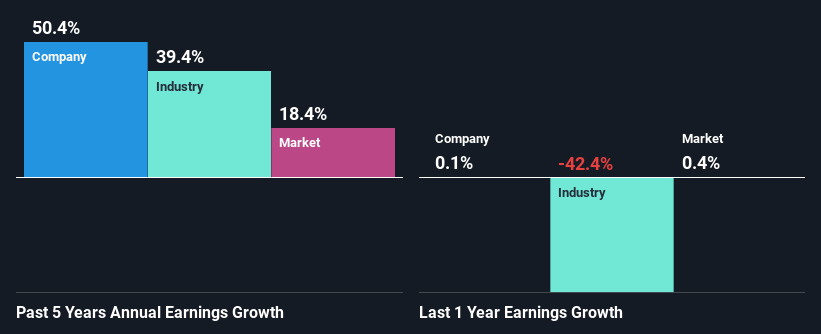PetroTal Corp.'s (TSE:TAL) Stock Has Been Sliding But Fundamentals Look Strong: Is The Market Wrong?
PetroTal (TSE:TAL) has had a rough month with its share price down 5.1%. But if you pay close attention, you might gather that its strong financials could mean that the stock could potentially see an increase in value in the long-term, given how markets usually reward companies with good financial health. Specifically, we decided to study PetroTal's ROE in this article.
Return on equity or ROE is an important factor to be considered by a shareholder because it tells them how effectively their capital is being reinvested. Put another way, it reveals the company's success at turning shareholder investments into profits.
Check out our latest analysis for PetroTal
How Is ROE Calculated?
The formula for return on equity is:
Return on Equity = Net Profit (from continuing operations) ÷ Shareholders' Equity
So, based on the above formula, the ROE for PetroTal is:
29% = US$141m ÷ US$489m (Based on the trailing twelve months to March 2024).
The 'return' is the yearly profit. That means that for every CA$1 worth of shareholders' equity, the company generated CA$0.29 in profit.
What Has ROE Got To Do With Earnings Growth?
So far, we've learned that ROE is a measure of a company's profitability. Based on how much of its profits the company chooses to reinvest or "retain", we are then able to evaluate a company's future ability to generate profits. Assuming all else is equal, companies that have both a higher return on equity and higher profit retention are usually the ones that have a higher growth rate when compared to companies that don't have the same features.
PetroTal's Earnings Growth And 29% ROE
Firstly, we acknowledge that PetroTal has a significantly high ROE. Additionally, the company's ROE is higher compared to the industry average of 9.6% which is quite remarkable. So, the substantial 50% net income growth seen by PetroTal over the past five years isn't overly surprising.
We then compared PetroTal's net income growth with the industry and we're pleased to see that the company's growth figure is higher when compared with the industry which has a growth rate of 39% in the same 5-year period.
Earnings growth is an important metric to consider when valuing a stock. What investors need to determine next is if the expected earnings growth, or the lack of it, is already built into the share price. This then helps them determine if the stock is placed for a bright or bleak future. What is TAL worth today? The intrinsic value infographic in our free research report helps visualize whether TAL is currently mispriced by the market.
Is PetroTal Efficiently Re-investing Its Profits?
PetroTal's three-year median payout ratio is a pretty moderate 38%, meaning the company retains 62% of its income. This suggests that its dividend is well covered, and given the high growth we discussed above, it looks like PetroTal is reinvesting its earnings efficiently.
Moreover, PetroTal is determined to keep sharing its profits with shareholders which we infer from its long history of five years of paying a dividend. Upon studying the latest analysts' consensus data, we found that the company's future payout ratio is expected to rise to 63% over the next three years.
Conclusion
On the whole, we feel that PetroTal's performance has been quite good. Particularly, we like that the company is reinvesting heavily into its business, and at a high rate of return. Unsurprisingly, this has led to an impressive earnings growth. That being so, according to the latest industry analyst forecasts, the company's earnings are expected to shrink in the future. Are these analysts expectations based on the broad expectations for the industry, or on the company's fundamentals? Click here to be taken to our analyst's forecasts page for the company.
Have feedback on this article? Concerned about the content? Get in touch with us directly. Alternatively, email editorial-team (at) simplywallst.com.
This article by Simply Wall St is general in nature. We provide commentary based on historical data and analyst forecasts only using an unbiased methodology and our articles are not intended to be financial advice. It does not constitute a recommendation to buy or sell any stock, and does not take account of your objectives, or your financial situation. We aim to bring you long-term focused analysis driven by fundamental data. Note that our analysis may not factor in the latest price-sensitive company announcements or qualitative material. Simply Wall St has no position in any stocks mentioned.
Have feedback on this article? Concerned about the content? Get in touch with us directly. Alternatively, email editorial-team@simplywallst.com

 Yahoo Finance
Yahoo Finance 
